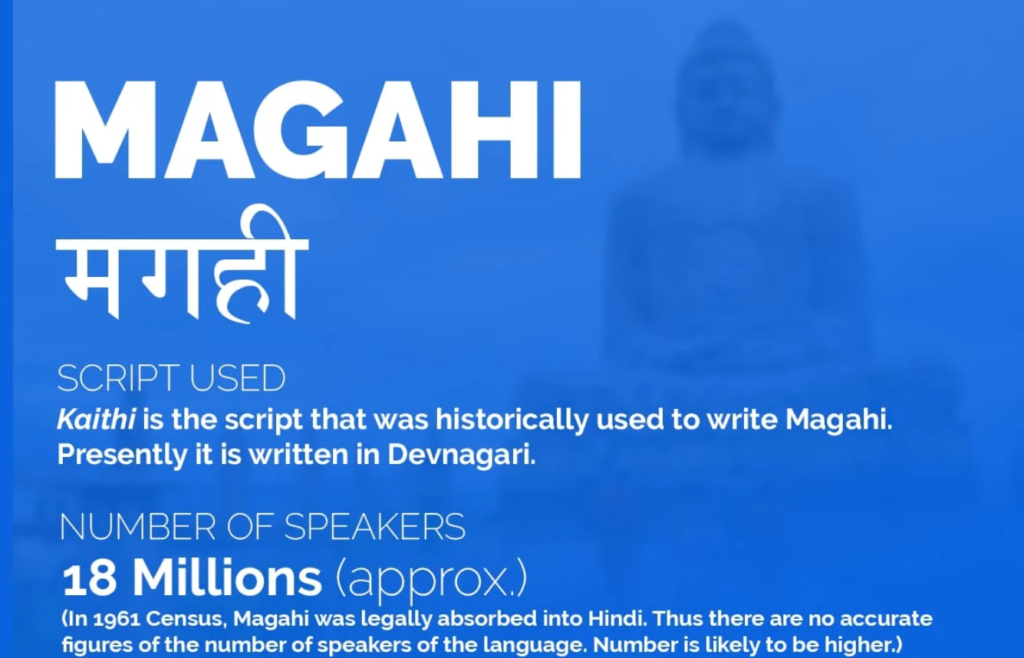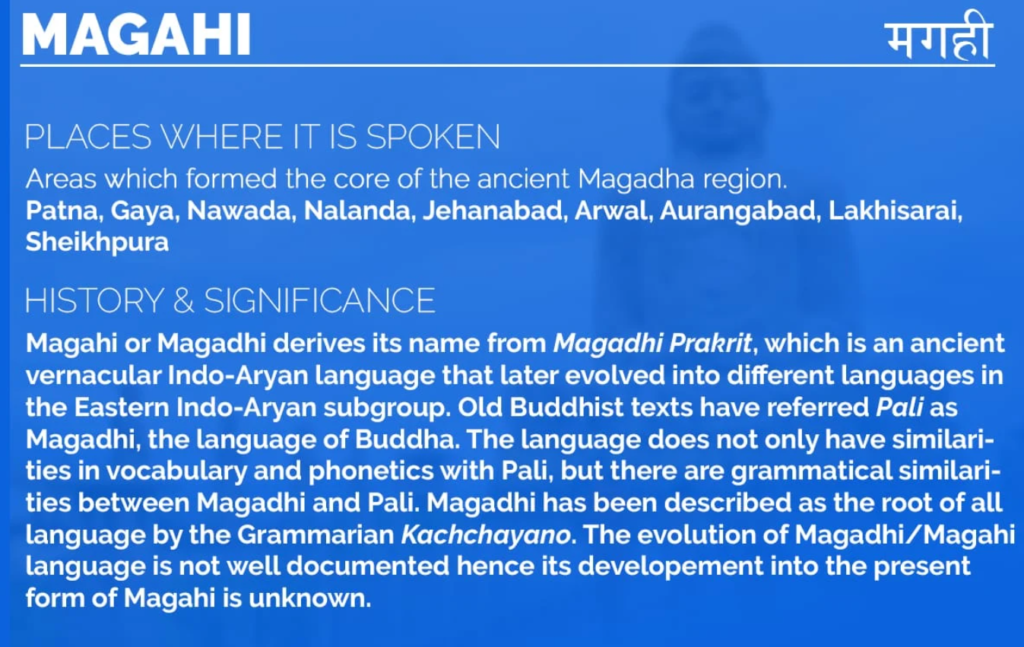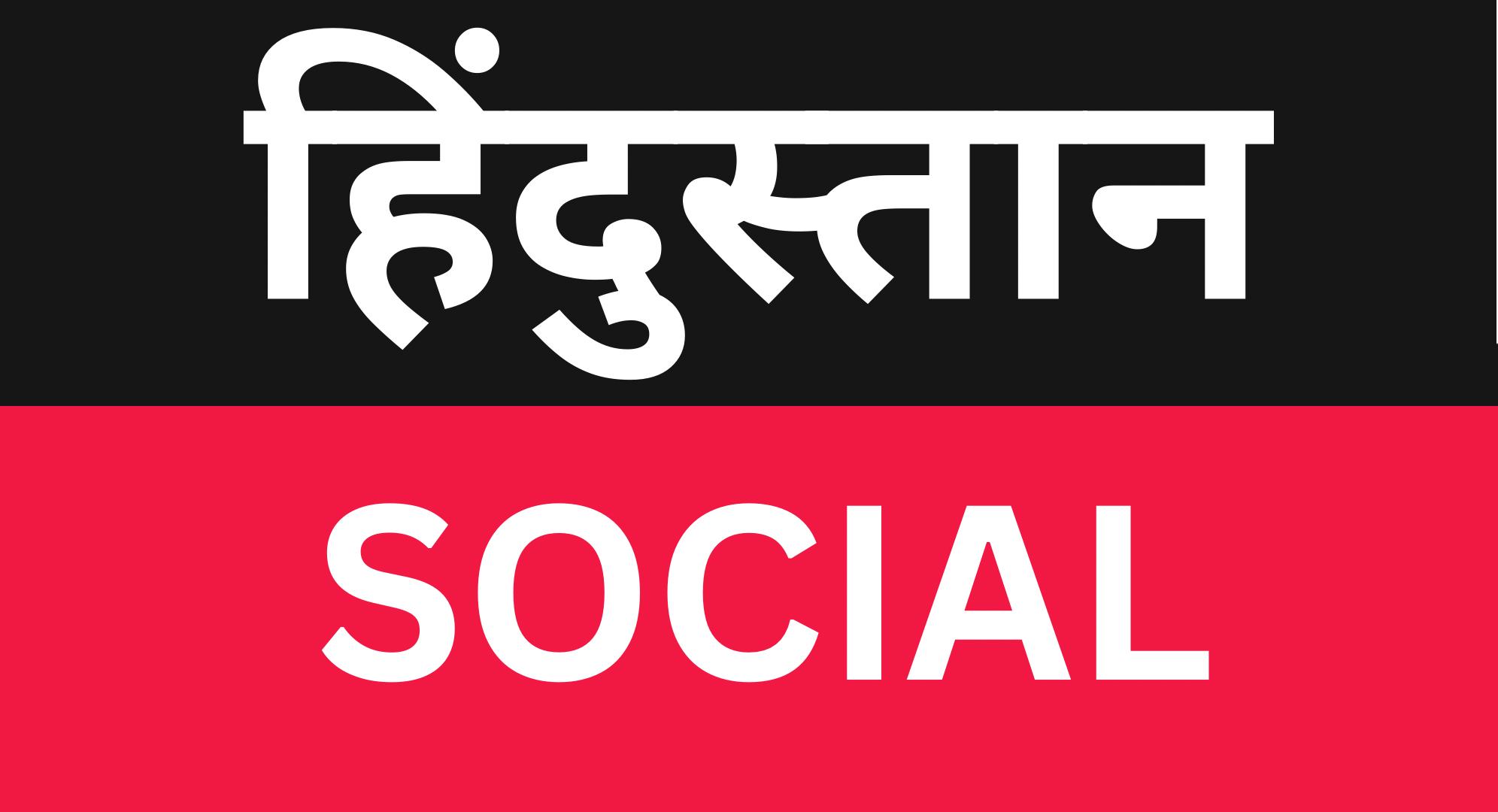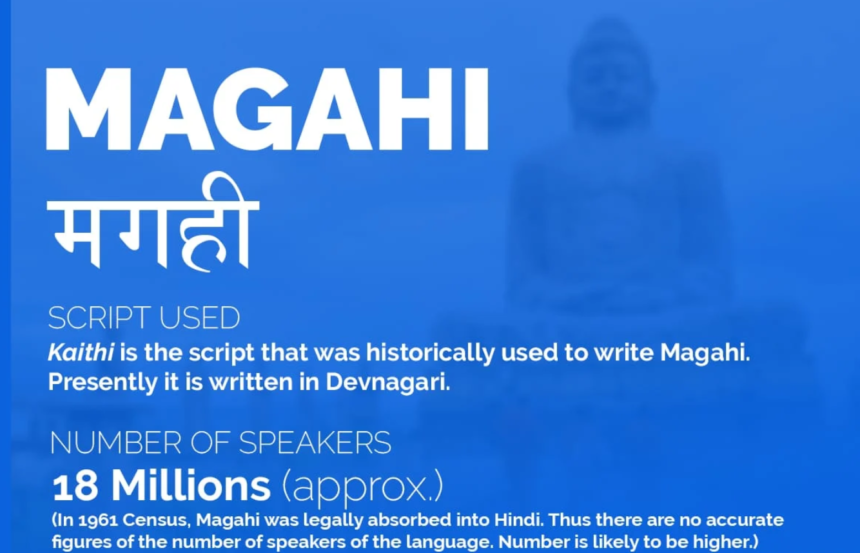Magahi, also known as Magadhi, is a language spoken primarily in the Indian states of Bihar, Jharkhand, and parts of West Bengal. It is a prominent member of the Bihari group of languages, which also includes Bhojpuri and Maithili. Magahi has a rich history, deeply connected to the ancient Magadh region and its cultural and historical significance. This language has played an essential role in shaping the cultural identity of the people of Bihar and surrounding areas.

Magahi is more than just a language; it is a cultural treasure, full of traditions, folklore, and a way of life that binds the community together. In this article, we will explore the history, significance, unique features, and current status of the Magahi language.
History of Magahi Language
The history of Magahi language can be traced back to ancient times. It is believed to be closely related to Magadhi Prakrit, which was widely spoken in the Magadh region (modern-day Bihar) during the time of the Buddha and Ashoka. In fact, many of the early Buddhist teachings were delivered in Magadhi Prakrit, making the language historically significant in the context of Indian religions and philosophy.

Magahi evolved from the Prakrit languages spoken in the region, and over time, it absorbed influences from Sanskrit and other regional languages. The name “Magahi” itself is derived from “Magadh,” the ancient kingdom that played a pivotal role in the development of Indian culture, politics, and religion.
Magahi’s roots in ancient Magadh make it one of the oldest languages in India. It is also closely connected to the development of languages like Pali and Sanskrit, which have left a deep impact on South Asian literature and culture.
Geographical Distribution and Influence
Magahi is spoken by millions of people, primarily in the Magadh region of Bihar, which includes cities like Patna, Gaya, and Nalanda. The language is also found in parts of Jharkhand and West Bengal. Though it is predominantly spoken in rural areas, it is still an important part of the cultural identity of the people in these regions.
Magahi is often regarded as a dialect of Hindi by some linguists, but it has its own distinct characteristics that set it apart from other languages. It is closely related to Bhojpuri and Maithili, which belong to the same language family but have their own unique features.
In terms of linguistic influence, Magahi has also played a role in shaping the dialects spoken in surrounding regions. While Hindi and Urdu have become dominant in India, Magahi still retains a strong presence in the lives of the people who speak it.
Unique Features of Magahi Language
Magahi, like other languages, has a unique set of features that make it distinct. These features include its pronunciation, vocabulary, grammar, and syntax.
- Pronunciation: The pronunciation of Magahi is quite distinct from Hindi and other Bihari languages. For example, Magahi speakers may pronounce certain consonants and vowels differently, which gives the language a unique sound. This aspect of the language is one of the key ways in which it stands apart from other regional languages.
- Grammar: Magahi follows a grammatical structure similar to that of other Indo-Aryan languages, but it has its own set of rules. It uses postpositions instead of prepositions, and its verb conjugations vary depending on the tense and subject. The subject-object-verb order is common, but certain grammatical structures are unique to Magahi.
- Vocabulary: Magahi has a rich vocabulary that contains words from Sanskrit, Prakrit, and other regional languages. Over time, the language has also incorporated words from Hindi and other modern languages, giving it a more diverse vocabulary.
- Syntax: The syntax of Magahi is relatively simple compared to more complex languages like Sanskrit. However, it retains some old features that link it to its ancient roots, especially in terms of word order and sentence structure.
Cultural Significance of Magahi Language
Magahi language is deeply woven into the cultural fabric of Bihar and the surrounding regions. It is not only a means of communication but also a vessel for tradition, history, and social practices.
- Folklore and Oral Traditions: Magahi has a rich tradition of oral storytelling. Folk songs, tales, and proverbs passed down through generations form a significant part of the region’s cultural heritage. These stories, often recounting the struggles and triumphs of ordinary people, are an integral part of festivals, weddings, and other celebrations.
- Magahi in Literature: The literary history of Magahi is not as well-documented as that of Hindi or Bengali, but it has an extensive oral literary tradition. Magahi folk poetry, songs, and even modern-day written works contribute to the rich literature of the region. Writers in Magahi often explore themes of love, nature, mythology, and daily life, providing insight into the culture and traditions of Bihar.
- Magahi in Music and Drama: Traditional Magahi folk music, such as Bidesia and Jhumar, plays an essential role in local festivals and ceremonies. These songs, performed in the Magahi language, capture the essence of life in rural Bihar. Local dramas and theater performances in Magahi also contribute to preserving the language and keeping it alive in modern times.
Challenges Facing the Magahi Language
Despite its rich history and cultural significance, Magahi is currently facing several challenges. The rise of Hindi and the dominance of English in education and media have pushed regional languages like Magahi to the background. As a result, the younger generation is increasingly shifting toward Hindi or English for communication, while the usage of Magahi is slowly declining.
Additionally, the lack of formal recognition for Magahi as a separate language has contributed to its marginalization. While Hindi and other languages like Bhojpuri and Maithili have gained prominence in the region, Magahi does not have the same level of institutional support.
Efforts to revitalize the language are underway, with local language activists pushing for greater recognition of Magahi in education, media, and literature. Initiatives to teach Magahi in schools and preserve its literature are important steps toward ensuring that the language does not disappear.
Magahi’s Role in Modern Times
Although Magahi is facing challenges, it still holds an important place in the everyday lives of people in Bihar and surrounding regions. It is used in family conversations, local businesses, and community gatherings. The language is also a symbol of local identity and pride for the people of Magadh.
There is a growing movement to preserve and promote Magahi, especially among the younger generation. Social media platforms, cultural organizations, and local institutions are helping spread awareness about the importance of maintaining the language. Furthermore, the rise of digital platforms provides new opportunities for the Magahi language to flourish and reach a global audience.
Conclusion
Magahi is more than just a language; it is a symbol of the rich cultural heritage of Bihar and its people. From its ancient roots in Magadhi Prakrit to its current status as a regional language, Magahi has contributed to the cultural and historical landscape of India. Though it faces challenges in the modern era, efforts to preserve and promote the language are critical for ensuring its survival.
As a language that connects people to their past, Magahi continues to play an important role in the daily lives of those who speak it. Its folklore, literature, and cultural practices remain vital aspects of the region’s identity, and the ongoing efforts to revitalize the language are an important part of preserving this precious cultural resource

